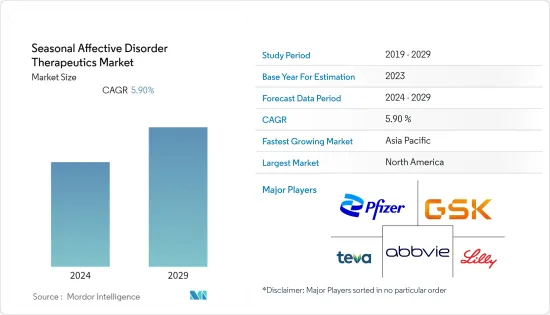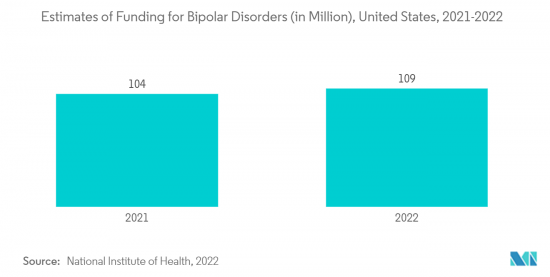
|
市場調査レポート
商品コード
1406168
季節性感情障害(SAD)治療薬:市場シェア分析、産業動向と統計、2024~2029年の成長予測Seasonal Affective Disorder Therapeutics - Market Share Analysis, Industry Trends & Statistics, Growth Forecasts 2024 - 2029 |
||||||
カスタマイズ可能
適宜更新あり
|
|||||||
| 季節性感情障害(SAD)治療薬:市場シェア分析、産業動向と統計、2024~2029年の成長予測 |
|
出版日: 2024年01月04日
発行: Mordor Intelligence
ページ情報: 英文 120 Pages
納期: 2~3営業日
|
全表示
- 概要
- 目次
季節性感情障害(SAD)治療薬市場は予測期間中にCAGR 5.9%を記録する見込み

主なハイライト
- COVID-19は調査対象市場に大きな影響を与えました。パンデミックの発生により、患者の受診が減少し、季節性感情障害の治療を求める患者が減少し、市場の成長に影響を与えました。パンデミックの進行に伴い、パンデミック関連の不安からうつ病罹患率が上昇しました。World Journal of Psychiatryに掲載された2021年6月の研究によると、COVID-19は世界の日常生活に大きな影響を与えました。この流行はメンタルヘルスに永続的な影響を及ぼし、世界の課題をもたらすと予測されました。パンデミック中の抑うつ症状の増加は、パンデミック後期に治療薬に対する需要を生み出し、その後の市場成長にプラスの影響を与えました。さらに、パンデミック後は、冬のような季節に人々が元気ややる気、元気を感じなくなることから、季節性情動障害(SAD)治療薬の採用が増加し、市場は大きなペースで成長すると予想されます。
- 市場成長を促進する要因には、季節性情動障害やうつ病の有病率の増加、研究開発活動の活発化、治療選択肢の増加などがあります。
- SADの有病率の増加は市場成長の原動力になると予想されます。例えば、2023年1月に更新された英国National Health Serviceによると、季節性情動障害(SAD)としても知られる冬の憂鬱は、北欧では1,200万人以上、英国では約200万人が罹患すると推定されており、子供を含むあらゆる年齢の人々がSADに罹患しやすいとされています。このような先進国におけるSADの高い有病率は、SAD治療薬の採用増加により市場の成長を促進すると予想されています。
- さらに、2022年6月に更新されたAnxiety and Depression Foundationの事実と統計によると、全般性不安障害は年間680万人の成人、または米国人口の3.1%が罹患しています。したがって、世界中のうつ病とSADのこのような膨大な症例は、予測期間にわたって調査された市場の全体的な成長を促進すると予想されます。
- 提携やSADの治療法の承認など、主要な市場関係者によるイニシアティブの高まりが、予測期間中の市場成長を促進すると予想されます。例えば、2022年3月、Sun Pharmaceutical Industries LimitedはH. Lundbeck A/Sと独占的特許ライセンス契約を締結し、インドでVORTIDIFのブランド名で独自バージョンのVortioxetineを販売・流通させることになりました。また、2022年2月、顆粒インディアは米国食品医薬品局からSAD治療薬として塩酸ブプロピオンの承認を取得しました。このような提携や承認は、SAD治療薬の市場での入手可能性を高め、市場の成長を促進します。
- したがって、SADの有病率の上昇と、SADの治療薬を発売するための市場プレイヤーのイニシアチブの高まりは、市場成長を促進すると予想される要因です。しかし、地域全体の認識不足、副作用の可能性、リスクは、季節性感情障害治療薬市場の成長を妨げる主な要因です。
季節性感情障害治療薬市場の動向
双極性障害が季節性感情障害治療薬市場で大きなシェアを占める
- 双極性障害は、予測期間中に大きな市場シェアを獲得する見込みです。このセグメントの成長要因としては、高ストレス、薬物乱用などのさまざまなリスク要因による双極性障害の有病率の増加、主要市場プレイヤーのイニシアティブの高まりなどが挙げられます。
- 精神障害の有病率の増加は、同分野の成長を促進すると予測されています。2022年1月に更新された国立精神衛生研究所によると、米国では精神疾患が一般的です。米国では2021年に成人の5人に1人が精神疾患を患っている(2021年には5,780万人)。さらに、メンタルヘルス財団が2022年に発表したデータによると、アメリカ人の9.5%が毎年、ディスチミア、重症うつ病、双極性障害などのうつ病性疾患に罹患しています。双極性障害は18歳以上の成人人口の約2.6%が罹患しています。男性も女性も双極性障害になる可能性は同じです。このような双極性障害の莫大な有病率は、双極性障害の治療薬の採用増加により、同分野の成長を促進すると予想されています。
- さらに、企業はターゲットとする業界におけるプレゼンスを維持するため、製品の発売や拡大に注力しています。例えば、2021年6月、Alkermes plc.は、統合失調症および双極性障害の維持単剤療法または躁病エピソードもしくは混合エピソードの急性期治療薬としての新薬(LYBALVI)の米国食品医薬品局の承認を取得しました。このように、双極性障害に対する薬剤の承認は、LYBALVIの採用を増加させ、セグメントの成長を促進すると予想されます。
- したがって、双極性障害の罹患率の増加は、同疾患の治療薬に対する需要を増加させ、ひいては全体的なターゲットセグメントの成長を助長しています。

予測期間中、北米が季節性感情障害治療薬市場で健全なシェアを占める
- 北米は季節性感情障害治療薬市場で大きなシェアを占めており、予測期間中も同様の動向を示すと見られています。
- 同地域の成長を促進する要因としては、季節性感情障害の有病率の上昇、同地域での製品上市の増加、主要市場プレイヤーの強固な足場などが挙げられます。季節性感情障害(SAD)は、季節的なパターンを持つ主要なうつ病性障害であり、季節性感情疾患の有病率の上昇は、同地域における市場拡大の原動力となる可能性が高いです。2022年2月に更新されたPsychology Todayのニュースによると、季節性感情障害は1,000万人のアメリカ人に影響を与え、さらに10%から20%が軽度のSADを患っていると推定されています。さらに、同じ情報源によると、SADは男性よりも女性に4倍多いです。米国ではSADの有病率が高いため、SAD治療薬の採用が増加し、同地域の市場成長を牽引しています。
- さらに、市場の著名なプレーヤーが行う主要な戦略的イニシアティブや、規制機関からの医薬品の承認も、地域の成長の原因となっています。例えば、2021年12月、FDAは双極性障害1型または2型の患者におけるうつ病エピソードの治療薬としてCaplyta(ルマテペロン)を承認しました。単独、リチウムとの併用、バルプロエート(デパコート)との併用が可能です。カプリタは経口カプセルで、1日1回、食事の有無にかかわらず服用でき、カプリタでは用量の変更は必要ないです。
- さらに、米国ではCOVID-19の流行が始まって以来、抑うつ症状を経験する人の数が増加しています。例えば、Mental Health Americaが実施し、2021年9月に更新された調査によると、mhascreening.orgでうつ病スクリーニングを受ける人の数も劇的に増加しています。2020年1月から9月までにうつ病検査を受けた人は53万人を超え、前年比62%増となっています。したがって、季節性感情障害(SAD)の症状発現を抑制するための治療薬の需要が増加し、ひいては対象市場の成長を大きく後押しする可能性が高いです。
- したがって、上記の理由により、季節性感情障害治療薬の北米市場は予測期間中に強化されると予想されます。
季節性感情障害治療薬産業の概要
季節性情動障害治療薬市場の競争は中程度で、少数の主要企業で構成されています。競合要因としては、抗うつ薬の上市の増加、SAD治療薬の承認の増加、うつ病の新薬開発のための研究開発活動の活発化などが挙げられます。市場に参入している企業には、AbbVie Inc.、Viatris Inc.(Mylan N.V.)、Pfizer Inc.、Eli Lilly and Company、GlaxoSmithKline plc.、Novartis AG、Teva Pharmaceuticals USA, Inc.、AbbVie Inc.、Sanofi AG、Johnson &Johnson(Janssen Pharmaceuticals, Inc.)などがあります。
その他の特典:
- エクセル形式の市場予測(ME)シート
- 3ヶ月間のアナリストサポート
目次
第1章 イントロダクション
- 調査の前提条件と市場定義
- 調査範囲
第2章 調査手法
第3章 エグゼクティブサマリー
第4章 市場力学
- 市場概要
- 市場促進要因
- 季節性感情障害およびうつ病の有病率の増加
- 研究開発活動の活発化と治療選択肢の増加
- 市場抑制要因
- 地域間での認知不足
- 副作用とリスクの可能性
- ポーターのファイブフォース分析
- 新規参入業者の脅威
- 買い手/消費者の交渉力
- 供給企業の交渉力
- 代替品の脅威
- 競争企業間の敵対関係の強さ
第5章 市場セグメンテーション(市場規模)
- 薬剤タイプ別
- 選択的セロトニン再取り込み阻害薬(SSRI)
- ノルエピネフリン・ドパミン再取り込み阻害薬(NDRI)
- モノアミン酸化酵素阻害薬(MAOI)
- その他の薬剤
- 障害タイプ別
- 単極性障害
- 双極性障害
- 販売チャネル別
- 施設販売
- 小売販売
- 地域別
- 北米
- 米国
- カナダ
- メキシコ
- 欧州
- ドイツ
- 英国
- フランス
- イタリア
- スペイン
- その他欧州
- アジア太平洋
- 中国
- 日本
- インド
- オーストラリア
- 韓国
- その他のアジア太平洋地域
- 中東・アフリカ
- GCC
- 南アフリカ
- その他の中東とアフリカ
- 南米
- ブラジル
- アルゼンチン
- その他の南米
- 北米
第6章 競合情勢
- 企業プロファイル
- AbbVie Inc.
- Eli Lilly and Company
- GlaxoSmithKline plc.
- Viatris Inc(Mylan N.V.)
- Novartis AG
- Pfizer Inc.
- Teva Pharmaceuticals USA, Inc.
- Otsuka Pharmaceutical Co., Ltd.
- Bausch Health Companies
- AbbVie Inc(Allergan plc)
- Sanofi AG,
- Johnson & Johnson(Janssen Pharmaceuticals, Inc.)
第7章 市場機会と今後の動向

The seasonal affective disorder therapeutics market is expected to register a CAGR of 5.9% during the forecast period.
Key Highlights
- COVID-19 significantly impacted the studied market. The onset of the pandemic led to a reduction in patient visits and fewer patients seeking seasonal affective disorder treatment, affecting market growth. As the pandemic progressed, depression rates rose due to pandemic-related fears. According to a June 2021 study published in the World Journal of Psychiatry, COVID-19 had a significant impact on global daily life. The outbreak was predicted to have a lasting influence on mental health, posing worldwide challenges. The increased depressive symptoms during the pandemic created a demand for therapeutics in the late pandemic stages, positively impacting market growth in the following years. Furthermore, post-pandemic, the market is expected to grow at a significant pace as people feel less energetic, motivated, and chipper in seasons such as winter, thereby leading to increased adoption of seasonal affective disorder (SAD) therapeutics.
- Certain factors that are driving the market growth include the increasing prevalence of seasonal affective disorder and depression, growing R&D activities, and the rising number of treatment options.
- The rising prevalence of SAD is expected to drive the market growth. For instance, according to the National Health Service, United Kingdom update in January 2023, the winter blues, also known as seasonal affective disorder (SAD), is estimated to affect more than 12 million people in northern Europe and about 2 million people in the UK and people of all ages, including children, are susceptible to SAD. Such a high prevalence of SAD in developed nations is anticipated to drive market growth due to increased adoption of SAD therapeutics.
- Furthermore, according to the Anxiety and Depression Foundation facts and statistics updated in June 2022, generalized anxiety disorder affects 6.8 million adults or 3.1% of the United States population per year. Thus, such huge cases of depression and SADs across the world are expected to drive the overall growth of the studied market over the forecast period.
- Rising initiatives from the key market players, such as partnership and approval of therapies for SAD, are expected to drive the market growth over the forecast period. For instance, in March 2022, Sun Pharmaceutical Industries Limited entered into an exclusive patent licensing agreement with H. Lundbeck A/S to market and distribute its own version of Vortioxetine in India under the brand name VORTIDIF. In addition, in February 2022, Granules India received approval from the United States Food and Drugs Administration for Bupropion Hydrochloride to treat SAD. Such partnerships and approvals lead to increased market availability of SAD therapeutics, driving market growth.
- Therefore, the rising prevalence of SAD and the rising initiatives from the market players for the launch of drugs for SAD are the factors expected to drive market growth. However, lack of awareness across the regions, probable side effects, and risks are the major factors hindering the seasonal affective disorder therapeutics market's growth.
Seasonal Affective Disorder Therapeutics Market Trends
Bipolar Disorder Segment Holds Significant Share in the Seasonal Affective Disorder Therapeutics Market
- Bipolar disorder is expected to attain a significant market share during the forecast period. The factors owing to the growth of this segment include the increasing prevalence of bipolar disorder owing to various risk factors, such as high stress, substance abuse, and other rising initiatives from the key market players, among others.
- The rising prevalence of mental disorders is anticipated to drive the segment growth. As per the National Institute of Mental Health updated in January 2022, mental illnesses are common in the United States. One in every five adults in the United States suffered from a mental illness in 2021 (57.8 million in 2021). Moreover, as per the data published by the Mental Health Foundation in 2022, 9.5% of Americans are affected each year by depressive diseases, such as dysthymia, severe depression, and bipolar disorder. Bipolar disorder affects about 2.6% of the population of adults over the age of 18. Men and women both have an equal chance of acquiring bipolar disorder. Such a huge prevalence of bipolar disorders is anticipated to drive segment growth due to the rise in the adoption of therapeutics for bipolar disorders.
- Additionally, companies are focused on product launches and expansion to maintain their presence in the target industry. For instance, In June 2021, Alkermes plc. received the United States Food and Drug Administration authorization for its new medication (LYBALVI) for schizophrenia and bipolar illness as a maintenance monotherapy or for the acute treatment of manic or mixed episodes. Thus, the approval of drugs for bipolar disorder is anticipated to increase the adoption of LYBALVI, driving the segment's growth.
- Therefore, the growing incidence of bipolar disorders has increased the demand for therapeutic drugs for the same, in turn aiding the overall target segment growth.

North America Holds a Healthy Share in the Seasonal Affective Disorder Therapeutics Market Over the Forecast Period
- North America is found to hold a significant share of the seasonal affective disorder therapeutics market and is expected to show a similar trend over the forecast period.
- The factors driving the growth of the region include the rising prevalence of seasonal affective disorder, rising product launches in the region, and the strong foothold of key market players, among others. Seasonal affective disorder (SAD) is a major depressive disorder with a seasonal pattern, and the rising prevalence of seasonal affective illness is likely to drive market expansion in the region. According to a Psychology Today news update in February 2022, it is estimated that seasonal affective disorder affected 10 million Americans, and another 10% to 20% percent may have mild SAD. Furthermore, according to the same source, SAD is four times more common in women than in men. The high prevalence of SAD in the United States leads to increased adoption of SAD therapeutics, driving market growth in the region.
- In addition, key strategic initiatives undertaken by prominent players in the market and approval of drugs from regulatory agencies are also responsible for regional growth. For instance, in December 2021, the FDA authorized Caplyta (lumateperone) to treat depressive episodes in people with bipolar 1 or 2 illnesses. It can be taken alone, with lithium, or with valproate (Depakote). Caplyta is an oral capsule that can be taken once a day with or without food, and no dose changes are needed with Caplyta.
- Furthermore, the number of people in the United States experiencing depressive symptoms has increased since the COVID-19 epidemic began. For instance, according to a study conducted by Mental Health America and updated in September 2021, the number of people taking depression screenings at mhascreening.org has risen dramatically as well. Over 530,000 people have taken the depression test between January and September 2020, up by 62% from the previous year. Hence, the demand for therapeutic drugs is likely to increase to control the onset of symptoms of seasonal affective disorder (SAD), in turn fueling the target market's growth significantly.
- Therefore, owing to the abovementioned reasons, the North American market for seasonal affective disorder therapeutics is expected to bolster over the forecast period.
Seasonal Affective Disorder Therapeutics Industry Overview
The seasonal affective disorder therapeutics market is moderately competitive and consists of a few major players. The factors owing to the competition include the rising launch of anti-depressant drugs, rising approvals of drugs for SAD, and increased R&D activities for the development of novel drugs for depression. Some of the companies operating in the market include AbbVie Inc., Viatris Inc. (Mylan N.V.), Pfizer Inc., Eli Lilly and Company, GlaxoSmithKline plc., Novartis AG, Teva Pharmaceuticals USA, Inc., AbbVie Inc, Sanofi AG, Johnson & Johnson (Janssen Pharmaceuticals, Inc), among others
Additional Benefits:
- The market estimate (ME) sheet in Excel format
- 3 months of analyst support
TABLE OF CONTENTS
1 INTRODUCTION
- 1.1 Study Assumptions and Market Definition
- 1.2 Scope of the Study
2 RESEARCH METHODOLOGY
3 EXECUTIVE SUMMARY
4 MARKET DYNAMICS
- 4.1 Market Overview
- 4.2 Market Drivers
- 4.2.1 Increasing Prevalence of Seasonal Affective Disorder and Depression
- 4.2.2 Growing R&D Activities and Rising Number of Treatment Options
- 4.3 Market Restraints
- 4.3.1 Lack of Awareness Across Regions
- 4.3.2 Probable Side Effects and Risks
- 4.4 Porter's Five Forces Analysis
- 4.4.1 Threat of New Entrants
- 4.4.2 Bargaining Power of Buyers/Consumers
- 4.4.3 Bargaining Power of Suppliers
- 4.4.4 Threat of Substitute Products
- 4.4.5 Intensity of Competitive Rivalry
5 MARKET SEGMENTATION (Market Size by Value - USD)
- 5.1 By Drug Type
- 5.1.1 Selective Serotonin Reuptake Inhibitors (SSRI)
- 5.1.2 Norepinephrine-Dopamine Reuptake Inhibitor (NDRI)
- 5.1.3 Monoamine Oxidase Inhibitor (MAOI)
- 5.1.4 Other Drug Types
- 5.2 By Disorder Type
- 5.2.1 Unipolar Disorder
- 5.2.2 Bipolar Disorder
- 5.3 By Distribution Channel
- 5.3.1 Institutional Sales
- 5.3.2 Retail Sales
- 5.4 Geography
- 5.4.1 North America
- 5.4.1.1 United States
- 5.4.1.2 Canada
- 5.4.1.3 Mexico
- 5.4.2 Europe
- 5.4.2.1 Germany
- 5.4.2.2 United Kingdom
- 5.4.2.3 France
- 5.4.2.4 Italy
- 5.4.2.5 Spain
- 5.4.2.6 Rest of Europe
- 5.4.3 Asia-Pacific
- 5.4.3.1 China
- 5.4.3.2 Japan
- 5.4.3.3 India
- 5.4.3.4 Australia
- 5.4.3.5 South Korea
- 5.4.3.6 Rest of Asia-Pacific
- 5.4.4 Middle East and Africa
- 5.4.4.1 GCC
- 5.4.4.2 South Africa
- 5.4.4.3 Rest of Middle East and Africa
- 5.4.5 South America
- 5.4.5.1 Brazil
- 5.4.5.2 Argentina
- 5.4.5.3 Rest of South America
- 5.4.1 North America
6 COMPETITIVE LANDSCAPE
- 6.1 Company Profiles
- 6.1.1 AbbVie Inc.
- 6.1.2 Eli Lilly and Company
- 6.1.3 GlaxoSmithKline plc.
- 6.1.4 Viatris Inc (Mylan N.V.)
- 6.1.5 Novartis AG
- 6.1.6 Pfizer Inc.
- 6.1.7 Teva Pharmaceuticals USA, Inc.
- 6.1.8 Otsuka Pharmaceutical Co., Ltd.
- 6.1.9 Bausch Health Companies
- 6.1.10 AbbVie Inc (Allergan plc)
- 6.1.11 Sanofi AG,
- 6.1.12 Johnson & Johnson (Janssen Pharmaceuticals, Inc.)


